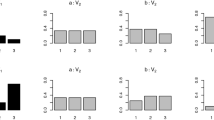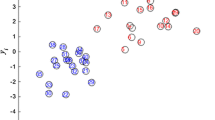Abstract
In data analysis tasks, we are often confronted to very high dimensional data. Based on the purpose of a data analysis study, feature selection will find and select the relevant subset of features from the original features. Many feature selection algorithms have been proposed in classical data analysis, but very few in symbolic data analysis (SDA) which is an extension of the classical data analysis, since it uses rich objects instead to simple matrices. A symbolic object, compared to the data used in classical data analysis can describe not only individuals, but also most of the time a cluster of individuals. In this paper we present an unsupervised feature selection algorithm on probabilistic symbolic objects (PSOs), with the purpose of discrimination. A PSO is a symbolic object that describes a cluster of individuals by modal variables using relative frequency distribution associated with each value. This paper presents new dissimilarity measures between PSOs, which are used as feature selection criteria, and explains how to reduce the complexity of the algorithm by using the discrimination matrix.
Similar content being viewed by others
References
Billard L, Diday E. Symbolic data analysis. John Wiley & Sons, Ltd., 2006
Diday E, Esposito F. An introduction to symbolic data analysis and the SODAS software. Intelligent Data Analysis, 2003, 7(6): 583–601
Diday E. Probabilist, possibilist and belief objects for knowledge analysis. Annals of Operations Research, 1995, 55(2): 227–276
Ziani D. Sélection de variables sur un ensemble d’objets symboliques: traitement des dépendances entre variables. Paris: University of Paris Dauphine, Dissertation for the Doctoral Degree 1996 (in French)
Lebbe J. Représentation des concepts en biologie et en médecine. Dissertation for the Doctoral Degree, 1991 (in French)
Bock H H, Diday E. Analysis of symbolic data: exploratory methods for extracting statistical information from complex data. Springer, 2000, 389–391
Ziani D. Feature selection on Boolean symbolic objects. International Journal of Computer Science & Information Technology, 2013, 5(6): 1
Malerba D, Esposito F, Monopoli M. Comparing dissimilarity measures for probabilistic symbolic objects. Data mining III, Series Management Information Systems, 2002, 6: 31–40
Rached Z, Alajaji F, Campbell L L. Rényi’s divergence and entropy rates for finite alphabet Markov sources. IEEE Transactions on Information Theory, 2001, 47(4): 1553–1561
Kullback S, Leibler R A. On information and sufficiency. Annals of Mathematical Statistics, 1951, 22(1): 79–86
Beirlant J, Devroye L, Györfi L, Vajda I. Large deviations of divergence measures on partitions. Journal of Statistical Planning and Inference, 2001, 93(1): 1–16
Ziani D, Khalil Z, Vignes R. Recherche de sous-ensembles minimaux de variables à partir d’objets symboliques. In: Proceedings of the 5th èmes Journées “Symbolique-Numérique”. 1994, 794–799 (in French)
Esposito F, Malerba D, Appice A. Dissimilarity and matching. Symbolic Data Analysis and the SODAS Software, 2008, 61–66
Frank A, Asuncion A. Uci machine learning repository [http://archive.ics.uci.edu/ml]. irvine, ca: University of california. School of Information and Computer Science, 2010, 213
Browne C, Düntsch I, Gediga G. Iris revisited: a comparison of discriminant and enhanced rough set data analysis. Rough Sets in Knowledge Discovery 2, 1998, 19: 345–368
Dash M, Choi K, Scheuermann P, Liu H. Feature selection for clustering — a filter solution. In: Proceedings of the 2002 IEEE International Conference on Data Mining. 2002, 115–122
Dy J G, Brodley C E. Feature selection for unsupervised learning. The Journal of Machine Learning Research, 2004, 5: 845–889
Author information
Authors and Affiliations
Corresponding author
Additional information
Djamal Ziani is an assistant professor in Computer Sciences and Information Systems College, King Saud University Saudi Arabia from 2009 until now. He is a researcher in ERP and in data management group of CCIS, King Saud University. He received his MS degree in computer sciences from University of Valenciennes, France in 1992, and his PhD degree in computer sciences from University of Paris Dauphine, France in 1996. Researcher in CLOREC project, INRIA Rocquencourt, France from 1992 to 1996. Post Doc in Department of Computer Sciences and Operational Research of University of Montreal, Canada from 1997 to 1998. Consultant and project manager in many companies in Canada from 1998 to 2009.
Rights and permissions
About this article
Cite this article
Ziani, D. Feature selection on probabilistic symbolic objects. Front. Comput. Sci. 8, 933–947 (2014). https://doi.org/10.1007/s11704-014-3359-4
Received:
Accepted:
Published:
Issue Date:
DOI: https://doi.org/10.1007/s11704-014-3359-4




